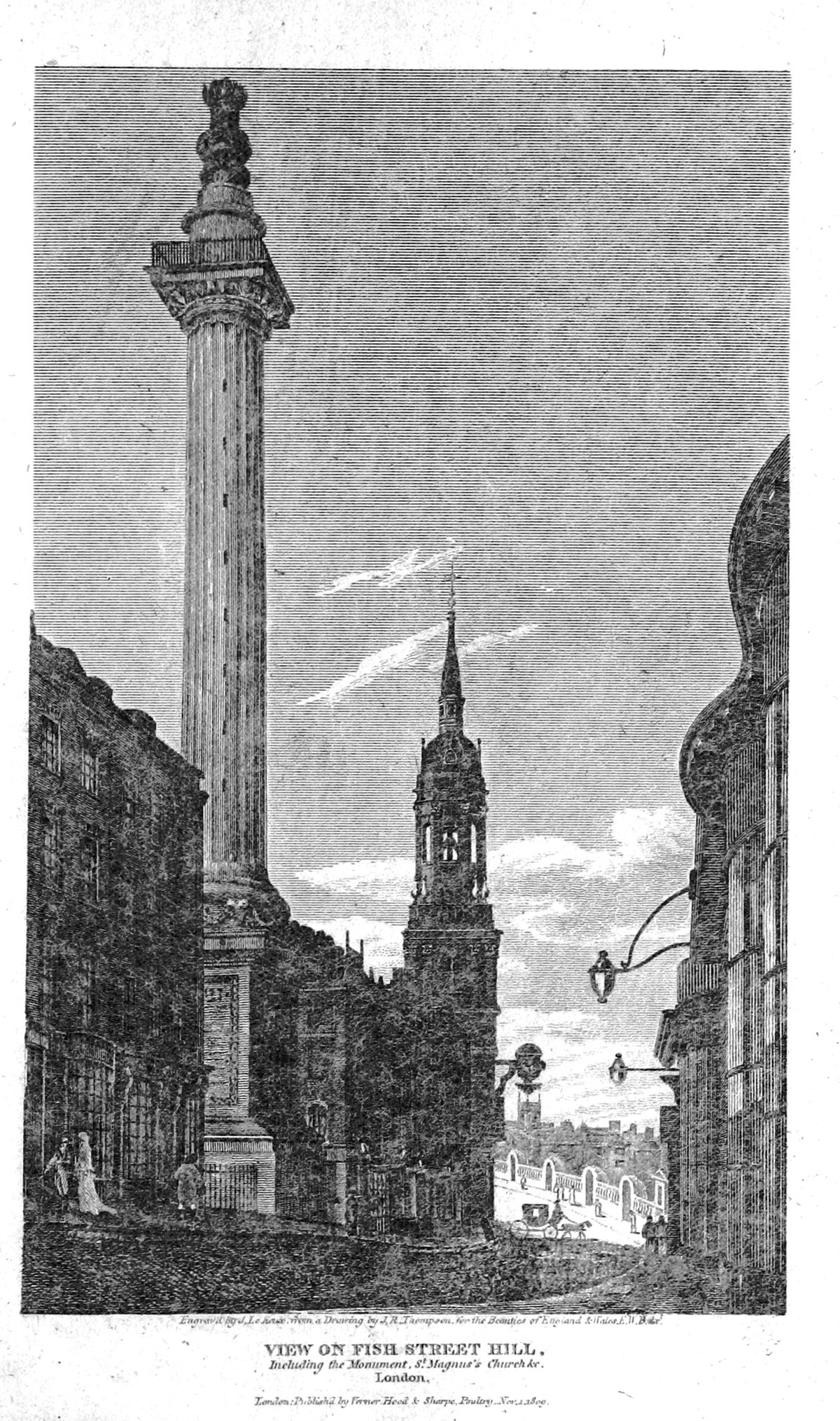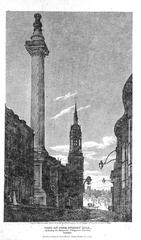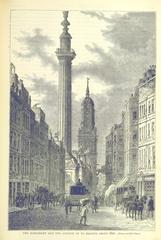
St Magnus-the-Martyr: Visiting Hours, Ticket Information, and Historical Significance in the City of London
Date: 15/06/2025
Introduction
St Magnus-the-Martyr stands as a remarkable symbol of London’s rich spiritual, architectural, and cultural heritage. Situated at the northern end of the historic London Bridge, this Grade I listed church has welcomed travelers, parishioners, and history enthusiasts for over a millennium. Its origins date back to the late Anglo-Saxon period, and its dedication to St Magnus Erlendsson, Earl of Orkney—a canonized Norse nobleman—reflects London’s deep-rooted connections to the wider European and Scandinavian world (Britain Express, London Parish Clerks).
Following its destruction in the Great Fire of London (1666), St Magnus-the-Martyr was masterfully rebuilt by Sir Christopher Wren, who introduced iconic Baroque features and innovative design elements. Today, the church offers visitors not only architectural marvels and treasures such as a detailed scale model of Old London Bridge but also vibrant worship, community events, and a welcoming atmosphere. This guide presents everything you need to know about visiting, from practical details to history, nearby attractions, and tips for an enriching experience (Eye Revolution, London On The Ground).
Table of Contents
- Introduction
- Early Origins and Medieval Foundations
- The Great Fire of London and Wren’s Rebuilding
- Architectural and Artistic Highlights
- Connection to London Bridge
- Parish Unions and Modern Role
- Visitor Information: Hours, Tickets, Accessibility
- Special Events, Guided Tours, and Cultural Life
- Nearby Attractions and Suggested Itineraries
- FAQs
- Conclusion and How to Stay Connected
- References
Early Origins and Medieval Foundations
The earliest records of St Magnus-the-Martyr suggest a church existed on the site by the late 11th century, with possible references dating back to 1067. Its location at the foot of London Bridge made it an essential stop for travelers and traders entering the City, establishing the church as a spiritual and civic hub for centuries (Britain Express, Eye Revolution).
The church is dedicated to St Magnus Erlendsson, Earl of Orkney, a saint renowned for his piety and martyrdom, whose legacy is commemorated in the church’s stained glass and annual festivals (City of London). The dedication’s confirmation in the 20th century followed centuries of debate about the church’s patronage (London Parish Clerks).
Throughout the Middle Ages, St Magnus-the-Martyr played a central role in parish life, closely connected with the City’s guilds—particularly the Worshipful Company of Fishmongers and Plumbers—and the administration of the Bridge ward (Square Mile Churches, The Romantic Traveller).
The Great Fire of London and Wren’s Rebuilding
The original medieval church was among the first destroyed in the Great Fire of 1666. Its proximity to Pudding Lane, where the fire began, sealed its fate (Eye Revolution). Sir Christopher Wren was appointed to design the new church, completed in 1676. Wren’s design features a rectangular nave with clerestory, round-arched windows, and a majestic west tower crowned by a striking steeple (added 1703–1706), transforming the City skyline (Square Mile Churches).
Architectural and Artistic Highlights
Exterior: The church’s Portland stone façade and tall arched windows embody the elegance of post-fire Baroque architecture. The unique pedestrian archway through the tower, added in 1763, allowed for the expansion of city streets without compromising the church’s presence (London On The Ground).
Interior: Inside, visitors are greeted by high barrel-vaulted ceilings, Corinthian columns, and a harmonious palette of white and gold. The ornate reredos, intricately carved woodwork, black and white marble floor, and stained glass depicting Old London Bridge and saints, create a sense of both grandeur and serenity (Londonist).
Artistic Features: The church contains a preserved timber from the Roman riverside wall (AD 65) and stones from Old London Bridge, connecting the physical structure to London’s ancient past (Britain Express).
Connection to London Bridge
For centuries, St Magnus-the-Martyr was not only adjacent to but physically connected with Old London Bridge. Remnants of the bridge can still be found in the churchyard. The church houses a remarkable four-meter-long scale model of medieval London Bridge, crafted in 1987 by David T. Aggett, featuring over 900 miniature figures and offering a vivid glimpse into medieval city life (Eye Revolution, Living London History).
Parish Unions and Modern Role
Over its history, St Magnus-the-Martyr absorbed the parishes of St Margaret, New Fish Street (1670) and St Michael, Crooked Lane (1831), reflecting changes in the City’s urban landscape (Wikipedia). Today, the church remains an active parish with a vibrant Anglo-Catholic tradition, hosting daily prayers, High Mass, and special services, and serving as guild church for the Worshipful Companies of Fishmongers and Plumbers. The rector’s unique title, “Cardinal Rector,” is a legacy of the church’s distinguished ecclesiastical history (The Romantic Traveller, Wikipedia).
Visitor Information: Hours, Tickets, and Accessibility
Opening Hours:
- Monday to Saturday: 10:00 AM – 4:00 PM
- Sunday: Open for worship services; visitor access after services
- Check the official website for updates and special event schedules.
Tickets:
- Entry is free; donations are encouraged to support the church’s preservation and community programs.
Accessibility:
- Step-free access at the main entrance
- Facilities for visitors with limited mobility
- Assistance dogs welcome
Photography:
- Allowed during general visitation (not during services or private prayer). Always check for signage or staff guidance.
Getting There:
- Nearest Underground stations: Monument (2 min walk), Bank, London Bridge
- Bus routes: 17, 21, 43, 133
Special Events, Guided Tours, and Cultural Life
St Magnus-the-Martyr hosts a variety of special events throughout the year, including the annual Blessing of the Thames (with Southwark Cathedral), concerts, and guild services (London Parish Clerks). Guided tours can be arranged by contacting the parish office or during City walking tours, illuminating the church’s history, art, and traditions.
The church’s liturgical life is distinguished by Anglo-Catholic worship, ceremonial music, and a welcoming community—a tradition of hospitality noted by visitors (Ship of Fools). After-service refreshments offer an opportunity to engage with parishioners and discover more about the church’s vibrant present.
Nearby Attractions and Suggested Itineraries
St Magnus-the-Martyr’s central location makes it ideal for inclusion in a wider exploration of London’s historic sites. Nearby attractions include:
- The Monument: Commemorating the Great Fire of London (2-minute walk)
- Leadenhall Market: Victorian covered market (7 minutes)
- Old Billingsgate Market: Former fish market and event venue (3 minutes)
- Southwark Cathedral: Historic church across the river (7 minutes)
- London Bridge: Iconic Thames crossing (5 minutes)
Combine these sites with your visit for a comprehensive London heritage experience (Trek Zone).
Frequently Asked Questions (FAQ)
Q: What are the visiting hours?
A: Monday to Saturday, 10:00 AM – 4:00 PM; Sundays for services. Always check the official website for updates.
Q: Is there an entry fee or ticket required?
A: Entry is free; donations are appreciated.
Q: Are guided tours available?
A: Yes, by arrangement or as part of City walking tours.
Q: Is the church wheelchair accessible?
A: Most areas are accessible; some historic features may pose challenges. Assistance is available.
Q: Can I take photographs?
A: Yes, except during services.
Q: Where is the nearest tube station?
A: Monument station is closest.
Q: Are there special events or concerts?
A: Yes—see the website for current listings.
Visuals and Virtual Tours
Explore the church online through virtual tours, high-resolution imagery, and interactive maps. Notable features include:
- Stained glass depicting Old London Bridge and saints
- The four-metre-long model of Old London Bridge
- Ornate reredos and historic memorials
- Exterior and interior architecture
Alt text suggestions:
- “Exterior of St Magnus-the-Martyr with Baroque architecture”
- “Interior view: gilded reredos and Corinthian columns”
- “Model of Old London Bridge on display inside St Magnus”
- “Stained glass window depicting St Magnus Erlendsson”
Summary and How to Stay Connected
St Magnus-the-Martyr is a living testament to London’s resilience, spiritual life, and architectural splendor. Its layered history—from Roman times, through medieval commerce and Wren’s Baroque vision, to its ongoing role in the community—makes it a must-visit for anyone seeking to understand the City’s heritage. With free admission, accessible facilities, and a warm welcome, your visit promises inspiration and discovery.
For the latest visitor information, events, and guided tours, consult the St Magnus-the-Martyr official website. Download the Audiala App for interactive audio guides and enhanced exploration of London’s historical sites. Follow the church on social media for timely updates and insider tips.
References
This article draws on and links to the following authoritative sources for further information:
- Britain Express
- Eye Revolution Virtual Tour
- City of London
- The Romantic Traveller
- Square Mile Churches
- London Parish Clerks
- London On The Ground
- Londonist
- London Walking Tours
- Ship of Fools
- Trek Zone
- National Churches Trust
- Wikipedia
- Audiala App





















































































































































































































































